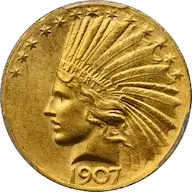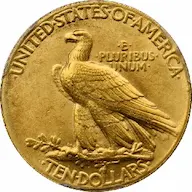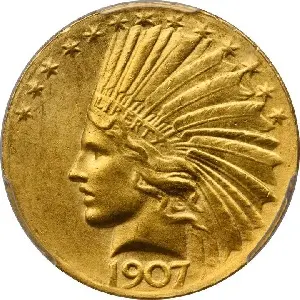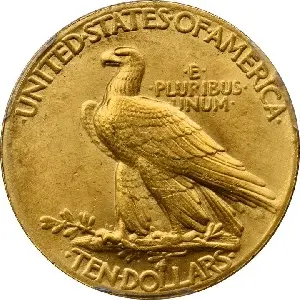1907 Indian Head $10 Eagle, Wire Rim, Periods
The story of the 1907 Indian Head “Wire Rim” $10 eagle closely tracks that of the 1907 Indian Head “Rolled Rim”$10 eagle.
Teddy Roosevelt is remembered as one of America’s most vibrant presidents. A fearless agent of change, Roosevelt sought to elevate the artistic qualities of United States coinage by tapping friend and acclaimed sculptor Augustus Saint-Gaudens to originate a new $10 gold eagle coin and a $20 double eagle.(1)
Roosevelt appreciated firsthand Saint-Gaudens’ talent when the artist sketched an Inauguration medal for the 1905 presidential ceremony.
From that time onward, it became the president’s personal mission to rejuvenate the image of American coinage. Beginning in November 1905 through May 1907, Roosevelt and Saint-Gaudens exchanged frequent letters on the development of new U.S. gold coinage.(2)
Saint-Gaudens devised versions of Liberty in full body appearance and bust portraits. He experimented with eagles in both in flight and repose. Initially, his plan was to depict the bust view of Liberty on the $20 double eagle, complimented by a standing eagle on the reverse. Eventually, it was the $10 gold coin upon which these design elements were placed.
At Roosevelt’s urging, Saint-Gaudens added a fictional Native American war bonnet to Liberty. The president considered it "distinctly American, and very picturesque." Hence the name “Indian Head” eagle is usually, but inaccurately, applied to this series of coins. The reverse featured a proud eagle astride a bundle of arrows, very similar to the Inaugural medal of 1905.
Indian Head $10 eagles were first produced in 1907. They possessed a thin, sharp rim rising above the coin’s perimeter and a higher than usual relief. Numismatists call this the “Wire Rim” variety, (often called "Wire Edge") differing from an elevated, rounded rim, which had long been the norm for United States coinage.
The Wire Rim variety possessed 46 raised stars on its edge, symbolizing the 46 states of the Union at the time, and had triangular-like periods interspersed within the lettering of E PLURIBUS UNUM, UNITED STATES OF AMERICA, and TEN DOLLARS. Because of their inability to stack well, the Wire Rim concept was jettisoned. Only 500 examples of this variety were struck.(3)
Next, a “Rolled Rim” was tried, characterized by a raised, rounded edge, appearing as customary rims shaped on coinage. The periods and stars remained. Unfortunately, this design typically resulted in a weakly struck coin. Before calling off the effort, 31,550 pieces of the Rolled Rim variety were produced.
A mintage this large suggests there were plans to release the Rolled Rim $10 eagle to the public, but the Mint abruptly reversed course because of quality concerns. Hence, the Rolled Rim variety is classified as a regular issue, not a pattern piece as was the Wire Rim.
All but 40 to 50 of Rolled Rim total were melted down at the Mint, creating a major rarity in U.S. numismatics.(4)
Improved strike quality was observed after the Indian Head eagle was retooled to remove the periods. Mass production of the “Rolled Rim, No Periods" ten dollar eagle began in November 1907. Before the close of the year, 239,406 of them were produced by the Mint.(5)
Augustus Saint-Gaudens died in August 1907, a few months before the first of his gold coins exited the Mint. The task of securing the final revisions was left to his able assistant, Henry Hering.
Today, numismatic historians praise Saint-Gaudens as a major contributor who helped raise U.S. coin design to a higher level, with a lot of help from his powerful friend in the White House.
The artistic genius of the 1907 Indian Head eagle (with periods), for both the Wire Rim variety and its younger brother, the Rolled Rim, combined with extreme scarcity, ignited an intense numismatic interest in the coin starting in 1908. Since then, it has only grown in stature among collectors, making it one of the most hotly pursued coins from the 20th century.(6)
| Estimated survivors in all grades: 450 ?
The survivor estimate from PCGS represents an average of one or more experts' opinions as to how many examples survive of a particular coin in all grades. Survival estimates include coins that are raw, certified by PCGS, and certified by other grading services. Learn more at PCGS. |
| PCGS Rarity Scale: 6.1 ?
The 'PCGS CoinFacts Rarity Scale' assesses the relative rarity of all U.S. coins, based on estimated surviving examples. The scale runs from 1.0 to 10.0. The higher the number, the rarer the coin.
Learn more at PCGS. |
| Search for the 1907 Indian Head $10 Eagle, Wire Rim, Periods on eBay** |
Preview of eBay selection:
 |
 |
| Trendline Avg = 11.78 | CLASSIC RARITY |
 |
 |
| Trendline Avg = 11.78 | CLASSIC RARITY |
Historic Value Trend Charts:
| Last updated 9-6-25 | Return to Key Date Coin List | |
| Compare to Common Date Coin of Same Type | ||
|
|
||
| Download Charts to Your Computer | ||
Sources
1. NGC. Indian Head $10 (1907-1933).
2. Taxay, Don. The U.S. Mint and Coinage. New York, NY: Sanford J. Durst Numismatic Publications, 1966.
3. NGC. Indian Head $10 (1907-1933).
4. Garrett, Jeff and Guth, Ron. 100 Greatest U.S. Coins, 5th ed. Pelham, AL: Whitman Publishing, 2019.
5. Taxay, Don. The U.S. Mint and Coinage. New York, NY: Sanford J. Durst Numismatic Publications, 1966.
6. Heritage Auctions. 1907 $10 Wire Rim. Aug 2019 Auction.
**Many very fine coin dealers sell on eBay. At any point in time, there may be over one million search results for United States coins. This includes quite a few of the recommendations on our Key Date Coin List.
If you’re thinking about purchasing a rare coin, eBay is certainly worth a look. For your convenience, the links from this site to eBay are coded to bring up only coins certified by PCGS and NGC.
As is always, always the case, never buy a valuable coin from a seller whose trustworthiness cannot be verified. Learn more about this at our chapter Best Places to Buy Coins, which also has a section on doing business on eBay.
In the interest of full disclosure, Rare Coins 101 receives a small commission anytime someone connects to eBay from this site and purchases something.
Coin images by Stack's Bowers Galleries.


